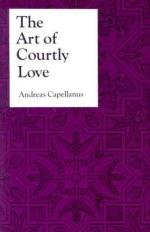
|
| Name: _________________________ | Period: ___________________ |
This test consists of 15 multiple choice questions and 5 short answer questions.
Multiple Choice Questions
1. According to the author, what is the only way that a lover can accept something of value from the beloved?
(a) If it is given freely.
(b) If it was painful for the giver to give.
(c) If the giver is in love, as well.
(d) Only if it caused the giver great joy.
2. In what stage of the four-stage theory of appropriate development of love should a woman try to find a lover?
(a) The first stage.
(b) The third stage.
(c) The fourth stage.
(d) The second stage.
3. Among the author's twelve rules for acquiring love, what did he have to say about two lovers' levels of desire?
(a) The woman should always exceed the man in desire.
(b) Neither should exceed the other in desire.
(c) The man should always exceed the woman in desire.
(d) Their levels of desire should always be absolutely identical.
4. Who was Walter?
(a) A blind man who could not love because he could not see.
(b) The author's real name.
(c) A good friend of the author.
(d) A nobleman who never knew true love.
5. Recalling the thing the author suggested a middle class man always do in a conversation with a middle class woman, when did he suggest that it be done in the course of a conversation?
(a) Early in the conversation.
(b) At the end of the conversation.
(c) In the middle of the conversation.
(d) Before the conversation really begins.
6. In the first dialogue, how did the conversation between the middle class man and the middle class woman begin?
(a) The man waited for permission to approach the woman, greeting her with reverence and made conversation.
(b) The man greeted the woman normally, but only because she was with another female.
(c) The woman initiated the greeting but allowed the man to make conversation.
(d) The man greeted the woman normally and the woman made conversation naturally.
7. If a middle class woman were to resist a middle class man because he is younger than she, how must the man respond?
(a) He must argue that he will live and love long and thus will become worthy of her love some day.
(b) He must remind her that beauty fades but it is good character than matters.
(c) He must use his wealth or other attribute to win her over.
(d) He must accept her rebuke and appraoch her again when he is older.
8. How did the author explain the link between love, perception and social class?
(a) Love makes peasants of all who love.
(b) Love is impossible for nobility to obtain.
(c) Love makes lovers feel like royalty.
(d) Love can make anyone a nobleman.
9. Despite her social rank, how might a middle class man perceive a noblewoman to be?
(a) Boring.
(b) Unsophisticated.
(c) Childish.
(d) Bad-mannered.
10. Of the five ways to acquire love, what should wise lovers look for to attain a lasting love?
(a) Ready speech.
(b) Good character.
(c) Beauty.
(d) Riches.
11. If a middle class woman was being pursued by a nobleman, what might she say to rebuff his advances?
(a) That he should find a suitable woman from his own class.
(b) That she suspected he was not good enough, even for her.
(c) That she should wait for a middle class man of good character.
(d) That she was not worthy of his attention.
12. What did the author note that women can achieve through marriage, but men cannot?
(a) Wealth.
(b) Protection from harm.
(c) Good character.
(d) Nobility.
13. What might a middle class woman have said to a nobleman about his social ranking if he had pursued her romantically?
(a) That he would lose social ranking entirely.
(b) That he might belittle his nobility.
(c) That he might slightly improve his social ranking.
(d) That he would greatly improve his social standing.
14. Which way of acquiring love does so with little effort?
(a) Riches.
(b) Ready speech.
(c) Good character.
(d) Beauty.
15. When a nobleman sat next to a middle class woman without permission, what message does he send?
(a) That he is in love with her.
(b) That he is not interested in pursuing her romantically.
(c) That he is of a higher class.
(d) That he was raised poorly and lacks good manners.
Short Answer Questions
1. According to the author in the Preface, what was his reason for writing the book?
2. In the dialogue between the nobleman and the noblewoman, how was the nobleman advised to respond when the noblewoman admitted that enjoying love was great and rejecting it was harmful, and though she was afraid of love's burdens, she had an interest in it?
3. The author cautioned that a man of low social standing approaching a woman of nobility unless the man be of what?
4. During a conversation between a nobleman and a noblewoman, what was she to give permission for him to do?
5. According to the author, upon what do lovers focus their attention?
|
This section contains 862 words (approx. 3 pages at 300 words per page) |

|




